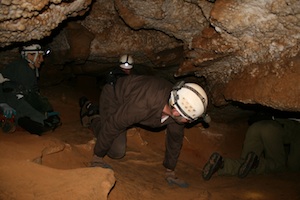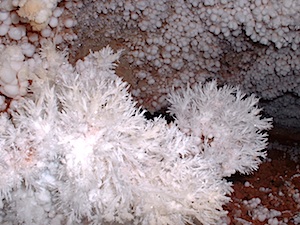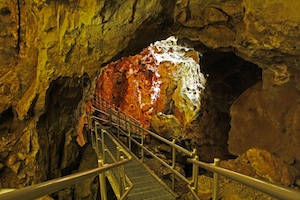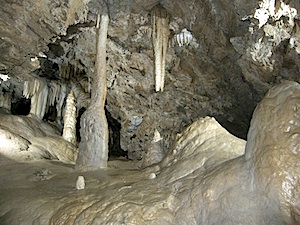While white-nose syndrome continues to plague bats in the country's cave systems, there nevertheless are quite a few underground tours you can take in the National Park System, tours that not only will show off these unique resources but also provide education on the disease.
For any of these cave tours, keep in mind that it's generally on the cool side underground -- in the 50s or so -- so bring a light jacket or sweater with you.
Home to the world's longest cave system -- 390-mile-long Mammoth Cave -- this park in Kentucky offers an array of underground tours. If you're just looking for an introduction to exploring underground, the Historic Tour leads you past sites visited by scientists, early explorers, and other notable individuals in the late 1800s and early 1900s. You'll see where Dr. John Croghan in 1841 had stone and wood huts built inside the cave for his tuberculosis patients, thinking that the air might cure them. The tour covers two miles in two hours and is great for families.
If you're looking for more of a thrill, consider signing on for the park's Wild Cave tour, in which you're outfitted in overalls, given a hard hat and knee protectors, and walk, shimmy, and squeeze by the light of your headlamp through sections of the cave for six to six-and-a-half hours. Definitely not for the claustrophobic, but if you like adventures, this is a great one.
There's even a special cave tour for youngsters -- Trog. This tour is geared to 8- to 12-year-olds and runs two-and-a-half hours. During that time underground the kids will cover about a mile-and-a-half, negotiating at times by headlamp, and learn about some of the critters that live underground.
There are many other cave tours at the park, and some are only offered at certain times of the year. Most tours are available during the summer months. For details, check out the park's Cave Tour page. Unfortunately, that page only offers the current season's tours, so if you're hoping to plan something for the coming summer you'll have to wait to see the tour schedule and related fees.

A Wild Cave tour at Mammoth Cave. NPS photo by Vickie Carson.
As far as white-nose syndrome, while a case of a long-eared bat being infected by the fungal disease was discovered earlier this month, that has not affected cave tours. You will have to go through a decontamination process, but it's quick and easy, and along the way you'll receive some information on WNS and the threat it poses.
Carlsbad Caverns National Park
Like Mammoth Cave, this national park often pops up when talk turns to caving. Located in southern New Mexico, Carlsbad also offers a nice suite of cave tours. Rangers are ready to lead you down into Kings Palace, Left Hand Tunnel, Lower Cave and Hall of the White Giant.
As with Mammoth Cave National Park, more tour options are offered during the summer months. To check on what's available, what the times are, and how much the tours cost, visit this page.
There also are self-guided tours into the Big Room and the Natural Entrance. For information on those, check this page.
Though WNS has not be detected at Carlsbad, park officials are very mindful of the disease and might not let you enter the cave if you're wearing clothing or boots that you've used for other caving experiences outside the park.
Located near the western border of South Dakota, Wind Cave National Park actually encompasses more than 40 caves, although tours are led in just the main "Wind Cave" cave, and then along only about 1.5 miles of the cave.
Among the handful of tours offered is one for visitors with limited mobility. And the park also offers written materials to hearing-impaired visitors.

Frostwork and popcorn at Wind Cave. NPS photo.
Due to reduced traffic during the winter months, not all tours are offered during those months. Come summer, though, things pick up and crowds can make it wise for you to be somewhat strategic in your planning, as tickets are first-come, first-served.
Park officials recommend that in summer the best time to visit the cave is during the early hours of the day. Somewhat surprisingly, during the summer weekends are good times to visit while Tuesdays and Wednesdays are the busiest days.
WNS has not been detected at Wind Cave. However, the park has developed protocols for dealing with the disease.
Crystal Cave is a bonus for visitors who head to Sequoia National Park anxious to see big trees. This cave, located off the Generals Highway between the park's Ash Mountain entrance and Giant Forest, is only open from mid-May through November.
Four tours are offered by the Sequoia Natural History Association: a Historic Candlelight Tour, Wild Cave Tour, Discovery Tour, and Junior Caver Tour.
During the caving season, same-day tickets can be purchased at the Foothills or Lodgepole visitor centers. Just be sure to factor travel time in from either of the visitor centers to the cave entrance, as it can take up to 90 minutes from either one.
WNS has not been detected in Crystal Cave but, as with Carlsbad, you will not be allowed in if you're wearing clothing or boots you used in some other cave. Also, you'll be asked to scuffle your footwear on mats bathed with Lysol as a disinfectant.
This might come as a surprise to some, but Jewel Cave in South Dakota boasts the second-longest cave in the world.

The Scenic Tour route at Jewel Cave. NPS photo by Eric Dodd.
"Jewel Cave" has been mapped across more than 160 miles. There are four tours offered at the monument: the Discovery Tour, the Scenic Tour, the Historic Lantern Tour, and the Wild Cave Tour.
Got time for just one tour? Seriously consider going on the Scenic Tour, which covers a half-mile loop that you walk in about 90 minutes. Along the way you'll be treated to such exquisite cave formations as calcite crystals, cave bacon, cave popcorn, and ribbon draperies.
Though it's considered "moderately strenuous" due to the more than 700 steps you need to navigate along the loop, the walk follows a paved, illuminated trail.
Fun factoid: From the elevator entrance, it takes over 11 hours for explorers to reach unexplored sections at the end of Jewel Cave. Some survey trips require cavers to remain underground for up to 4 days.
Fun factoid two: On January 2, 2013, explorers discovered another 6,870 feet of Jewel Cave.
Though perhaps best known for its ancient bristlecone pines, Great Basin National Park in Nevada along the Utah border has a secret underground: Lehman Caves. And, like Wind Cave National Park, the boundaries of Great Basin encompass more than 40 caves. But the main attraction is Lehman Caves. This is an unusual "marble" cave system. Along with the somewhat common cave popcorn, soda straws, flowstones, stalactites, stalagmites, and helictites, you'll also find several hundred rare shield formations.
As with the other national park cave systems, tours are offered on a scaled-back schedule during the winter months. From June through August you can find 90-minute tours of the Grand Palace leaving at 9 a.m., 11 a.m., 1 p.m., 2 p.m., and 3 p.m. daily. Sixty-minute tours of the Lodge Room leave at 8:30 a.m., 10:30 a.m., 12:30 p.m., 2:30 p.m. and 4 p.m.
During the winters (which run until June for scheduling purposes), tours of the Grand Palace are offered at 9 a.m. and 1 p.m. Tours of the Lodge Room depart at 11 a.m. and 3 p.m. When staffing permits, the park offers a Historic Candlelight Tour. Check the park's website, or ask when you reach the park, when these might be resumed.
WNS has not been detected at Great Basin, though you will be asked to perform some simple decontamination procedures before entering Lehman Caves.

"Joaquin Millers Chapel" in Oregon Caves. NPS photo by Shawn Thomas.
Oregon Caves National Monument
Cave tours at this national monument in Oregon are on hiatus until March. Once that month rolls around you'll be able to explore on 90-minute ranger-led tours. The route is only a half-mile long, but is considered moderately strenuous due to the more than 500 steps you need to negotiate. You also need to scoot through a 45-inch-tall passageway. If you're a bit uneasy about this, there is a way out of the cave halfway into the tour.
Oregon Caves has its own form of "Wild Cave" tour that it refers to as "Off-trail Caving." Trained guides lead you on these three-hour adventures, teach you a bit about spelunking, how to use ropes to safely negotiate passageways, and bring you closer to the marble structure of this cave system.
As with other parks' wild cave tours, sign up for this program and you'll find yourself squirming along on your belly, or hands and knees, as you explore the cave system all by the light of your headlamp.
WNS has not been detected here, but you won't be allowed into the cave system if you're wearing clothing or footwear you've used in caves east of the Rocky Mountains, even if you've washed the gear.
Timpanogos Cave National Monument
There actually are three caves at this monument in Utah: Hansen Cave, Middle Cave, and Timpanogos Cave.
The Park Service runs 45-60-minute cave tours through Timpanogos Cave daily from mid-May through mid-October that are limited to 16 people per tour. The cave as described by the Park Service as being unique for "its high abundance of helictites, its coloration in its formations, its display of fault-controlled passages."
Also offered is a 90-minute Caving Tour that introduces visitors to caving and cave ethics. "Although it is not a wild caving experience, the tour does require bending, crawling, and passage through tight spaces," the park says.
Now, the toughest part about caving at Timpanogos just might be the 1.5-mile-long trail you need to walk to reach the cave entrance. This trail climbs more than 1,000 feet, and in summer, with temperatures reaching 100 degrees and the elevation a breath-taking 7,546 feet, it can be an arduous climb if you're not in shape or coming from sea level.
The above are just some of the more recognizable caves to tour in the National Park System. Others can be found at Cumberland Gap National Historical Park in Kentucky, Ozark National Scenic Riverways in Missouri, Craters of the Moon National Monument in Idaho, Hawaii Volcanoes National Park, and Lava Beds National Monument in northern California. (See attachment)


 Support Essential Coverage of Essential Places
Support Essential Coverage of Essential Places







Comments
Ozark NSR probably deserves more than a small mention at the bottom. Ozark is home to one of the best examples of Karst topography in America and has over 300 caves and springs. And Round Spring Cave is well worth a visit; the cave tours are limited to 15 people and use electric lanterns instead of lighting emplacements to give people a more natural look at the cave. Some of the most beautiful (personal opinion) springs are also found in the park. Ozark National Scenic Riverways is certainly worth a more in depth look.
Good point, Ranger Paul. Sometimes it's hard to cover all the bases in this sort of story. The way they handle tours at Round Spring Cave definitely would be a unique visitor experience.
I understand. I just wanted to make sure my park was not left out.